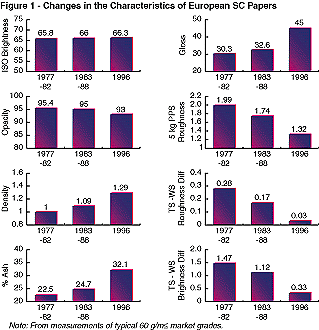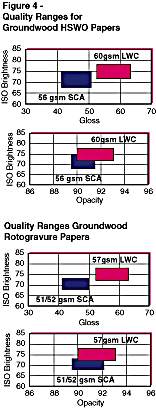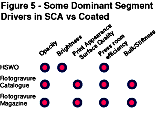|
In the first of two articles on SC papers, we look at the technical issues and innovations that are set to shape market demand in the future
by JC Veness and AA Williams
Uncoated groundwoods: looking to the future
Advances in paper production technologies have led to marked improvements in a number of the physical, optical and performance characteristics of supercalendered (SC) papers over the past 20 years. These advances have made a significant impact on the market and have proved especially important for a competitive group of paper grades - lightweight coated groundwood papers (LWC).
In many instances, LWC and SC serve very similar end-use markets and it is interesting to note the linkage between the two grades in the marketplace. In the first instance, we have to look at the production of uncoated SC publication papers in Europe and examine the most significant sub-sectors within the category in order to illustrate the major end-use markets.
Putting the European SC market in a global perspective, the total production of SC papers around the world amounted to some 5 million tons in 1997, with western European mills producing 3.5 million tons of that volume, or 70%. Almost all other SC production is centered in North America and there is no meaningful SC output to be found elsewhere in the world.
In consumption terms, western Europe again dominates with over a half of the world total. In 1997, North America's share of global consumption stands at 38% - higher than the production share due to the importation of 630,000 tons of European SC papers. European producers supplied almost all the consumption elsewhere in the world.
Looking in more detail at western Europe, there are two major categories of SC paper available. SCA accounts for some 82% of European production and typically has higher filler loading levels and a brightness range of 69% ISO and upward. SCB grades make up the balance.
Table 2 illustrates Finland's dominance in SC production and shows Germany's significant position in the SCB ranking. It is also worth noting that there are two clear subdivisions of SCB - papers produced in central Europe predominantly use deinked pulp (DIP), while grades produced in the Nordic countries mainly use virgin fiber.
| Table 1 - SC Uncoated Groundwood Papers Worldwide, 1997 |
| |
Total Production
(1,000 tons) |
Consumption Across
World Markets (%) |
| Western Europe |
3,500 |
52 |
| North America |
1,500 |
38 |
| Other |
nm |
10 |
| Total |
5,000 |
100 |
|
| Note: SC is taken to be European SCA and SCB qualities and similar qualities from North America. |
Table 2 - - SC Papers in Western Europe
Major producing countries
(1,000 tons) |
| |
SCA |
SCB |
| FinIand |
1,234 |
180 |
| Germany |
605 |
234 |
| Norway |
480 |
- |
| Austria |
296 |
141 |
| Sweden |
210 |
- |
|
| Note: The distinction between SCA and SCB in Europe is based primarily on brightness. |
Making the change
Figure 1 shows how some of the more important characteristics of European SCA papers have changed over the last two decades. The figure shows that there has been remarkably little change in average brightness levels, but surface properties have shown considerable improvement.

This has been the result of advances in calendering techniques, higher filler levels and improved paper machine technology. Twin-wire forming in the 1980s and gap forming technology more recently have both played a leading role in the quality improvements, particularly on the dramatic improvement in two-sidedness. The measurements also indicate some tailing off in the average opacity levels achieved over the period.
The quality of typical LWC grades in Europe has improved significantly over the same 20-year period in terms of average brightness, gloss and opacity. In contrast to the static SC picture, LWC brightness has shown steady advances, widening the differential between the two grades. But despite an improvement in LWC gloss levels since the mid-1980s, SC producers have succeeded in narrowing the gap. In addition, average LWC opacity levels have shown a marginal improvement, while there has typically been a slight deterioration among SC papers.
SCA consumption in western Europe totaled 2.1 million tons in 1997, with what would generally be considered "standard" SCA accounting for 1.7 million tons, or 80% of overall SCA production. Within that total though, there are two very important niche segments:
- SC CAT grades, which show opacity benefits, especially at lower basis weights
- SC HiBrite grades, which typically exhibit brightness levels of 72% ISO and above.
Approximately 240,000 tons of SC CAT was produced in western Europe in 1997, while SC HiBrite output reached just 160,000 tons. Currently, both of these markets are very small in tonnage terms, but they may well have considerable potential for further development in the future.
If we look at the main SCA quality ranges, it is worth noting the breakdown in end-users. For example, magazines and other publications make up the bulk of the end-usage with 78% of the total market. The remainder is split fairly evenly between catalogs and "other" uses such as inserts and flyers. As a result, 82% of the paper is gravure printed, while heat-set web offset (HSWO) printing is used for the rest.
All SC CAT is printed using gravure presses and although these papers were designed for the catalog market, they are also popular for other end-use applications.
In contrast to the above two categories, 65% of HiBrite production finds its way on to HSWO presses, and consequently these grades are often found in the insert, flyer and general printing market. Some 85% or so of the total HiBrite output in western Europe will be used in magazine/publications applications.
Distinctive touch
SC papers sold into the magazine and catalog markets are in direct competition with coated mechanical grades, where purchasing decisions are taken on relative price and quality and performance considerations. For the purposes of this paper, we will stick to the technical issues, but first we should look at some of the main market distinctions involved in the sector.
An analysis of the basis weight profiles of SCA and coated mechanical grades shows a very clear concentration of SCA in the 51-59 g/m range, while there is a much more even distribution among the competitive coated grades. Indeed, SCA is rarely found in the heavier weight sector above 65 g/m.
As noted previously, the magazine and publications market provides the major outlet for standard SCA. But the picture for coated mechanicals (LWC and MWC) is somewhat different. Just over a half of these paper grades are used in the magazine market, with catalogs accounting for a further 31% of the total. Since coated volumes amount to more than twice those of SCA in Europe, it is apparent that coated grades dominate the overall catalog market. Indeed, coated mechanicals account for some 1.7 million tons of the market, compared with 350,000 tons for SCA.
The same volume influence also means that despite the lower proportion of sales going into magazines and publications (52% compared with 73%), coated grades account for more of the paper used in the sector than SC papers. The tonnage of coated paper is 2.86 million, compared with 1.53 million tons for SC (Figure 3).



Plotting brightness against gloss and opacity for both SCA and LWC, we can see what happens in commercial practice for both the HSWO and gravure sectors. In both instances we have quoted different basis weights for SCA and LWC. What can be seen is that in the HSWO sector for example, if a printer decides to change in either direction then, typically, a 56 g/m SCA will be substituted for a 60 g/m LWC or vice versa.
Technological advances have enabled SCA to approach LWC in terms of both brightness and opacity in the HSWO sector, but is still well adrift on gloss. The differences are more pronounced in gravure. There is very little overlap between coated and uncoated stock in terms of brightness measurement and SCA grades are still gloss deficient. In contrast, opacity shows 51/52 g/m SCA fast approaching the levels achieved by a 57 g/m LWC sheet.
Back to basics

In order to understand these quality comparisons and try to gauge what the future may hold, we have summarized the dominant drivers in the major SCA segments of HSWO, rotogravure catalog and rotogravure magazine in Figure 5. The circles represent key importance in each segment.
While segment development opportunities may derive from performance factors such as brightness and print appearance, the most important elements in this table concern opacity and press room efficiency. With the sole exception of lightweights where opacity is sometimes sold as a performance advantage over coated stock, these properties are related directly to the cost-effective use of SCA papers. As cost competitiveness is a key selling point for SCA, there will be overwhelming pressure not to compromise on these quality attributes. This will be particularly true in the rotogravure magazine segment, due to its dominant volume.
Taking these points into account, we can conclude that:
- SCA will predominantly seek to preserve its cost efficiency, both in terms of production cost and in cost-related quality to the customer. (For example, opacity and press room efficiency.)
- special segments may develop through the development of properties such as opacity, brightness and print appearance, but these will be limited by the primary demands of cost.
Production cost efficiency will remain an overriding consideration in the future of SCA and, together with the cost-related attributes of opacity and press room efficiency, will play a dominant role in the development of quality and the exploitation of new market segments.
JC Veness and AA Williams work for ECC International, headquartered in St Austell in the UK
|